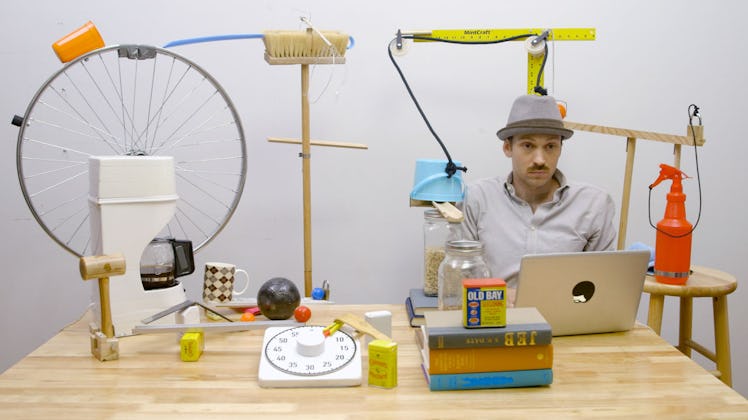How To Build Easy Rube Goldberg Machines From Household Objects
Because just "eating the toast" is sooooo boring.

For more advice on fun stuff to do with your kids, from ridiculously overqualified experts, check out the rest of our 940 Weekends.
Nobody really knows how to play Mousetrap — you may not have even realized there was a point to it. But that game is the basic idea behind Joseph’s Machines, Joseph Herscher’s comically kinetic chain reaction constructions (aka, Rube Goldberg machines). The idea is, you take a simple task and try to make it happen in the most elaborate and Pee Wee Playhouse-esque way possible. Herscher has created ridiculous mechanized solutions for things like licking stamps, turning newspaper pages, and even getting dressed that has been featured on things you kid likes to watch (Sesame Street) and things Kanye likes to watch (the Venice Biennale). Here are his tips on making your own unnecessary (but entertaining) machine with your kid.
Build What You Know
Some of the first machines Herscher made were designed out of necessity — at least from a 6-year-old’s perspective. “I made a machine for storing candy. It was basically just a box with a tube that you’d put your hand in, and no one could get it but me,” he says.
Herscher says that just getting your kids to play is the best place to start. “Let’s say I want to do something with books. I’ll get a hold of lots of different sizes, and just play with them for awhile, without thinking about how they’ll work in machines,” he says. “If there’s something that amuses me I’ll record that and end up using it.”
Get Some Cheap Thrills
You don’t need to spend tons of money on contraption parts. Herscher moved into his current Brooklyn apartment primarily because it’s above a 99 cent store (location, location, location), where he gets about half of his materials. The rest are found on the street, in thrift shops, or trash picked. “I might spend days looking for a particular type of cup or particular type of spatula,” he says. One man’s trash is another man’s essential component to an overly complex mechanism to make himself breakfast.
Stay Away From Motors And Gears
As a general rule, Herscher shies away from electronics. “I like to use everyday objects and repurpose them for the machine,” he explains. “Maybe I’ll use an electric toothbrush if I’m using the motor to trigger something, or have a timer go off to pull a string, but it’s still an everyday object. To me, it’s more interesting when you’re seeing familiar objects used in unfamiliar ways.” It’s just like how your kid uses his underwear as a hat.
Do It Backwards
A great Rube Goldberg machine is like a great joke: it’s more structured than you think, and it should really have a punchline. That word, “punchline,” is actually how Herscher likes to use to refer to the end of every machine. Getting that to work is always step one. Get the big, riskier mechanisms out of the way first (like things that are supposed to cut, break, or go splat) and then connect them.
Use A Lot Of Moving Parts
When it comes to core parts, bigger is always better. “Working with tiny marbles and light pieces of cardboard is tremendously unpredictable,” says Herscher. A golf ball should be as small as you go — and a bowling ball you can use at your own risk.
Work on a level surface.“Making the track as flat as possible slows [the ball] down and makes it much easier to follow,” says Herscher. “Think about the pacing of the machine, making [the moves] really clear and visible and not too hard to understand.” And just about anything can be used as a track: Open books, leftover cardboard, or that hamster maze that is tragically unoccupied.
Make Use Of Pulleys And Levers
Know your way around levers and pivots. “I use a lot of levers, like the hammers in [the Venice Biennale video],” says Herscher. “When you make a lever with a pivot point, don’t drill a hole too big for the rod or the whole thing is going to be wobbly. What you’re trying to do is minimize random variation.” In other words, it should do the same thing over and over again.
Can’t Stop Won’t Stop
“The biggest mistake I find kids make is that they make [a stage of the machine] and it works once, and they think the times that didn’t work were freak accidents,” says Herscher. To avoid a tantrum later, he recommends testing each step 10 times in a row. If it’s just not working and they’re frustrated, make a significant change. “Don’t just tweak it. Think ‘What’s a more different way I could do this?’”
Don’t Try This At Home
“I do avoid fire as a general rule,” says Herscher. “There’s a step in [The Page Turner] that boils water, but no one likes watching water boil. So instead of using water, I used nail polish remover. I didn’t realize that it was extremely flammable. The acetone caught fire, and I had to get a bucket of water and dump it all over my machine.”
The other thing he avoids: Animals. “There’s a machine I did for changing a light bulb that has a parrot in it that eats a grape on cue to shift weight,” says Herscher. “In rehearsal it worked fine, but as soon as we dimmed the lights for the shot, he got really sleepy and refused to eat it.” Unfortunately, you’re going to have to discourage your kid from incorporating a special appearance by the family dog.
Want tips, tricks, and advice that you’ll actually use? Click here to sign up for our email.
This article was originally published on